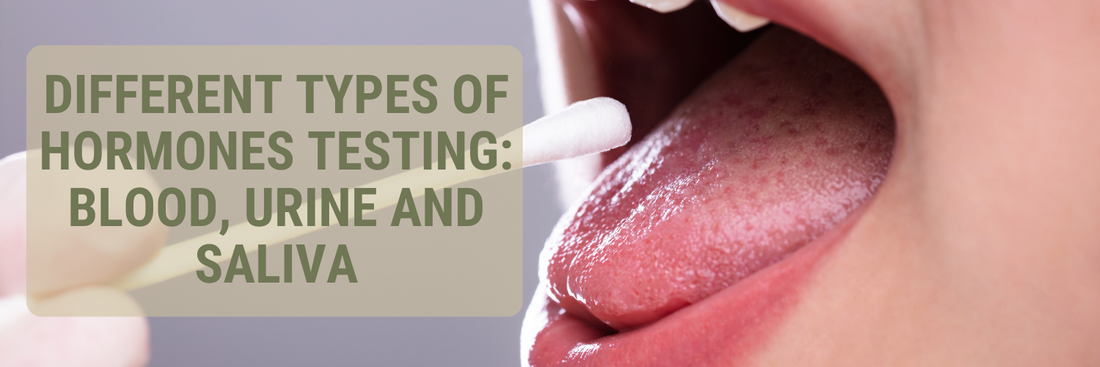Hi friends! Today I want to talk about different ways we can test our hormone levels and, why I prefer to use salvia testing in my practice!
There are three different ways to test hormones:
- Blood
- Urine
- Saliva
Different practitioners prefer different methods of testing, for different reasons!
For example, if you go to your PCP or OBGYN and ask to have your hormones tested, they will send you to the lab for a blood test (if they agree to do it at all because let’s be honest, it’s notoriously difficult to get traditional Drs to run full hormones labs).
On the other hand, most functional medicine practitioners will test hormones with either salvia or urine (DUTCH test). There are pros and cons to each.
For the purpose of this blog, I am going to compare blood and urine testing to salvia testing being that salvia is my preferred method to use with clients.
Saliva Testing vs. Blood Testing:
In the body, almost all hormones circulating in the bloodstream are bound to carrier proteins. Unlike blood-based tests, saliva diagnostics can measure the amount of free, unbound hormones that are available to act in the body. Salivary concentrations represent the hormone levels that are most likely to impact the body. By measuring these levels, we can determine which hormones are available and present in excess and where there may be a deficiency.
While a blood test measures hormone levels, it can only detect the hormones in the blood serum. These hormones are bound to protein and are not free to affect other organs and systems in the body. It’s not a reliable picture of how much of the body’s hormones are available, unbound and ready for delivery and use by tissues and organs.
Important points:
- Non-invasive: Saliva testing is a non-invasive method of collecting samples for hormone analysis. Unlike blood testing, saliva testing does not require needles or any other invasive procedures, making it a more comfortable and convenient option for patients.
- Ease of collection: Saliva samples can be collected easily and quickly, and can be done at home, whereas blood testing typically requires a visit to a laboratory or medical facility.
- More accurate representation: Saliva testing provides a more accurate representation of the body's bioavailable hormones (the hormones that are actually available for use by the body) than blood testing, which measures the total amount of hormones in the blood, including those that may be bound to carrier proteins and therefore not available for use.
- Better reflection of hormonal changes: Saliva testing also provides a more accurate reflection of hormonal changes over time, as hormone levels in saliva tend to change more rapidly than in blood. This makes it a useful tool for monitoring hormonal fluctuations in women during their menstrual cycle, for example.
Saliva Testing vs. Urine Testing:
These are simply different tests and both have their pros and cons. Saliva testing for free hormones has allowed me to get the best and most consistent results with clients, contrary to assessing how the body is metabolizing these hormones via urine testing (DUTCH).
Note that…a superior test might be these two combined, but unfortunately that would be unaffordable for 99% of people, and clinical practice has shown that it isn’t necessary to get consistent results.
The main difference here is looking at what has been used (urine) and what is free and available to the tissue (saliva).
Important points:
Clinically I have found saliva testing for hormones to be more reliable than urine testing due to a few reasons:
- More accurate reflection of free, biologically active hormones: Saliva testing measures the concentration of free, biologically active hormones, which are the hormones that are available to act on target tissues in the body. Urine testing, on the other hand, measures the total amount of hormones (both bound and unbound) that have been excreted by the body, which may not be an accurate reflection of the amount of hormones that are biologically active.
- Saliva testing is non-invasive, while urine testing requires a 24-hour urine collection, which can be inconvenient and uncomfortable.
- Saliva testing is more sensitive than urine testing, meaning it can detect lower levels of hormones in the body. This makes it useful for monitoring hormone levels in people who may have subtle hormonal imbalances or who are undergoing hormone therapy
- More stable hormones: Saliva samples are more stable than urine samples, which can be affected by changes in hydration status, the time of day, and other factors.
Overall, saliva testing for hormones may provide a more accurate and convenient way to measure hormone levels than urine testing, particularly for monitoring hormones over time or for assessing hormone levels in response to treatment. However, it is important to note that both testing methods have their own advantages and limitations, and the choice of testing method may depend on the specific hormone being measured and the clinical context in which the testing is being done.
I’d love to work with you to get those hormones back in balance! Check out my full hormone lab and coaching option below!
https://rachelstephenswellness.com/products/hormones-lab-30-min-consultation

